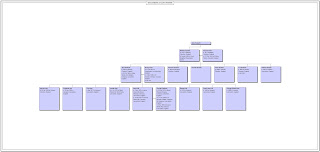Pictures can be worth a thousand words
Wikipedia offers the following explanation of the saying ‘A picture is worth a thousand words’: it “refers to the notion that a complex idea can be conveyed with just a single still image, or that an image of a subject conveys its meaning/essence more effectively than a description does. It also aptly characterizes one of the main goals of visualization, namely making it possible to absorb large amounts of data quickly.”
I was reminded of this adage on my recent visit to England when I spent time with my mum and brother. I explained in my August post that I had spent many hours before my trip trying to fill in the gaps in my mum’s pedigree chart and write up some level of narrative of the various branches of her ancestry. To help my mum follow the narrative and see how everyone fitted in, I printed out a main pedigree chart, which comprised eight A4 pages taped together, as well as smaller family charts of the different branches (the one below is for John Hesketh and Eliza Duckers of Cheshire). I didn’t have this pedigree chart printed professionally as it was still a ‘work in progress’ and also I ran out of time before I left. What surprised me, but in retrospect should not have, was that my mum was drawn more towards the visual representation of her family on the pedigree chart, rather than the detailed information that I had written down. In hindsight, I should have included much more of the visual material I had, such as photos, maps, images of documents, etc, to guide her through the intricacies of her family history, of which there are many.
 |
| Descendants of John Hesketh and Eliza Duckers |
Was it a coincidence that this point was reflected in an article I came across by Graham Barker, Glimpses of the past, in the July issue of Family Tree magazine? I don’t usually read this magazine but was looking for something to read in the inevitable wait while my car was being serviced. Barker outlined four writing activities, focussed around a photo or other resource, to act as a stimulus to write a short piece of approximately 200 words. The aim of the writing activity was to convey the meaning behind the particular resource.
I can see how the idea of writing a short piece is appealing to those who don’t normally put pen to paper, but in reality it’s quite difficult to encapsulate within 200 words what a family portrait, photo, heirloom, letter, or other item means to you. It may be preferable not to start with something that is so close to your heart, that it is impossible, and perhaps even unacceptable, to restrict your story to 200 words: you have to be quite objective to do this.
As a starting point, I suggest writing a draft with the intention of reviewing and revising. I usually put all my ideas down, let them sit for a day or so, then go through the revision process. In this way, I hopefully come up with something that is much more readable and succinct. Barker included a six-part checklist, developed by a biographer Midge Gillies, to guide writers through the revision process. Three elements of the six-part checklist are particularly helpful: Does every fact deserve to be there?; Are my facts right?; Is there anything I don’t understand?
These ideas are not new; you will find variations on them in most guides to writing. Another way to conceptualise these activities is to imagine you’re writing a blog post (this one is around 600 words). You can start with just a few notes, such as what the item is, how you acquired it, its link to you. As you jot down your notes, the story can take over and lead you in many different directions. I don’t think it’s worth worrying in the beginning about the number of words. The important thing is to convey the meaning that an item or resource has to you.
Until next time.
Pauline

Comments
Pictures can be worth a thousand words — No Comments
HTML tags allowed in your comment: <a href="" title=""> <abbr title=""> <acronym title=""> <b> <blockquote cite=""> <cite> <code> <del datetime=""> <em> <i> <q cite=""> <s> <strike> <strong>